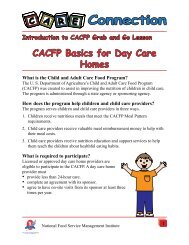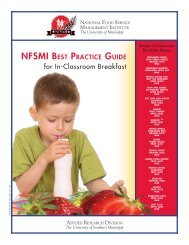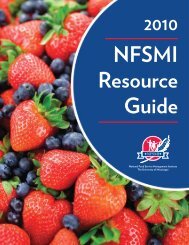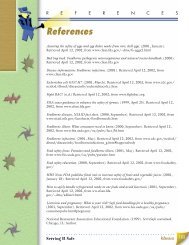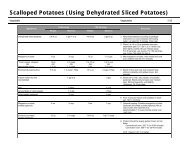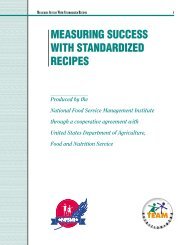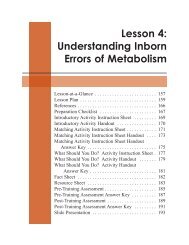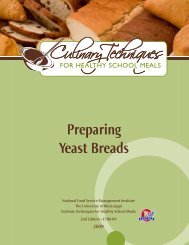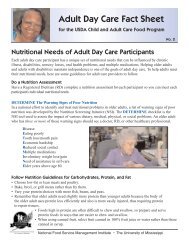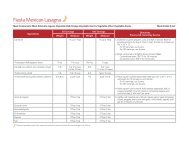financial management information system - National Food Service ...
financial management information system - National Food Service ...
financial management information system - National Food Service ...
You also want an ePaper? Increase the reach of your titles
YUMPU automatically turns print PDFs into web optimized ePapers that Google loves.
S ECTION 2BASIC FINANCIAL STATEMENTSManaging the <strong>financial</strong> resources of the school foodservice operation is critical to the success of the program. One of themost important aspects of <strong>financial</strong> <strong>management</strong> involves preparation of <strong>financial</strong> statements that can be used to analyzeprogram operations. Before <strong>financial</strong> statements can be prepared and analyzed, basic accounting principles and <strong>financial</strong><strong>management</strong> concepts must be in place to provide a uniform basis for gathering, recording, and interpreting <strong>financial</strong> data.Although the <strong>financial</strong> <strong>management</strong> guidelines presented here are not “written in stone,” they provide a model forrecording and classifying transactions that allows the user to summarize and interpret the <strong>financial</strong> data for making better<strong>management</strong> decisions.In order to make <strong>financial</strong> <strong>management</strong> decisions, the school foodservice administrator must have knowledge of basicaccounting principles. Accounting is an <strong>information</strong>-processing activity that provides recorded <strong>financial</strong> data important tomaking <strong>financial</strong>ly sound business decisions. In basic accounting procedures there are primarily two methods fordetermining when to record a <strong>financial</strong> transaction.• Cash basis accounting recognizes an accounting transaction at the point of cash inflow or outflow. While cash basisaccounting is the simpler of the two methods, it may not provide the user with an accurate reflection of the <strong>financial</strong>status of the operation.• Accrual basis accounting recognizes revenue when it is earned regardless of when cash is received and recognizesexpenditures when they are incurred regardless of when payment is made. An accrual basis accounting methodprovides a more meaningful evaluation of the school foodservice program because it matches expenditures to revenues.Many school foodservice programs use a blending of the two methods to record transactions. This method is best referredto as modified accrual. Although expenditures are matched with revenues in these operations, there are situations in whichsome expenditures, such as the payroll, do not exactly match the accounting period. In some school foodservice programs,these costs may not be adjusted to the accounting period as is required when using the accrual method. Another variationin the method of recording accounting transactions often occurs when a school district purchases major equipment. Inaccrual accounting, the total cost of purchasing furniture and equipment is not expensed in the period in which they arepurchased. Instead, a pro rata share of the cost in the form of depreciation expense is charged to each accounting periodduring the useful life of long-lived purchases. Under current reporting guidelines to USDA, equipment is considered anexpense one time only — when it is purchased.Evaluating and monitoring the school foodservice operation should be an ongoing process. Two <strong>financial</strong> statements thatcan be used to help school foodservice administrators analyze the effectiveness of their programs are:• the Statement of Revenue and Expenditures, also known as the Profit and Loss Statement, and• the Balance Sheet.N ATIONAL F OOD S ERVICE M ANAGEMENT I NSTITUTE 14



